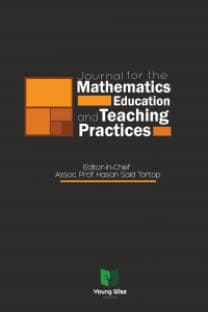The use of interdisciplinary approach in geometry teaching: The example of Arab-Islamic civilization
The use of interdisciplinary approach in geometry teaching: The example of Arab-Islamic civilization
Arab-Islamic civilization, Geometry teaching Interdisciplinary geometry, Mathematic anxiety,
___
- Adawi, G. (2019). The Documentary Film and the Photographic Image as Means of Significant Learning. Amman Dar Al-Shuruk.
- Barth, R. (2002). The Photographic Message. The Midrasha [Photography, Text, Art], 5, 21-33
- Barth, R. (1980). Thoughts on Photography (pp. 1-64). Jerusalem: Keter.
- Barnes, J. W. (Ed.). (2014). Complete Works of Aristotle. In The Revised Oxford Translation (Vol. 1). Princeton: University Press.
- Bishop, A. J. (2008). Mathematics teaching and values education – An intersection in need of research. In P. Clarkson & N. Presmeg (Eds.), Critical Issues in Mathematics Education (pp. 231-238). Melbourne, Australia: Springer.
- Bishop, A. J. (1988). Mathematical Enculturation: A Cultural Perspective on Mathematics Education. Dordrecht: Kluwer academic publishers.
- Daher, W. (2004). Integration of the History of Mathematics in the Teaching and Study of Mathematics. Jama’a, 8, 422-471.
- Edri, Y. and Movshovitz-Hadar, N. (2014). Values Education in a Disciplinary Framework – Study of Action in Mathematics Lessons. Research and Study of Mathematical Education, 2, 15-42.
- Fischbein, E. (1993). The theory of figural concepts. Educational Studies in Mathematics, 24, 139-162.
- Gal, H. (2011). From another perspective-training teachers to cope with problematic learning situations in geometry. Educational Studies in Mathematics, 78(2), 183-203.
- Goldstein, B. (2007). All photos lie: Images as data. In G. C. Stanczak (Ed.), Visual Research Methods: Image, Society, and Representation. Los Angeles: Sage Publication.
- Gravemeijer, K. & Doorman, M. (1999). Context problems in realistic mathematics education: A calculus course as an example. Educational Studies in Mathematics, 39, 111-129.
- Harper, D. (2005). What’s new visually? In N. K. Denzin & Y. S. Lincoln (Eds.), The SAGE Handbook of Qualitative Research. Thousand Oaks: Sage Publications.
- Hoffer, A. (1981). Geometry is more than proof. Mathematics Teacher, 74(1), 11-18.
- Ismaeli Y., Autaf, A. (March 10, 2015). The Role of Educational Tools in Enrichment of Academic Activity at the University Drawn on 15.06.2022:from the website: http://manifest.univ-ouargha.dz/index.php/seminaries
- Katzaf, Ada. (2004). The Study of Mathematics as Part of the People’s Civilization: The Connection of Humanistic Mathematical Education to the People’s Civilization. Mathematics Teacher’s Newsletter, 20-25, 31.
- Katzaf, Ada. (2006). Mathematics in Israel and Worldwide: Ethnomathematics: The Radiant Face of Mathematics as Emerging from Various World Civilizations. Strong Number 2000, 11, 30-35
- Lester, F. K. (Ed.). (2007). Second Handbook of Research in Mathematics Learning and Teaching. Reston, VA: National Council of Teachers of Mathematics.
- Ministry of Education. (2013). Junior High School Mathematics Curriculum. Jerusalem: Ministry of Education and Civilization, Department for Planning and Development of Curricula.
- Ministry of Education. (2006). Elementary School Mathematics Curriculum. Jerusalem: Ministry of Education and Civilization, Department for Planning and Development of Curricula.
- Mussarwa, H. (2012). The Study of Geometry based on the Study of Cultural Contexts. Dissertation for Receipt of Doctor of Philosophy (PhD), Technion, Haifa.
- Orey, D. & Rosa, M. (2007). Cultural assertions and challenges towards pedagogical action of an ethnomathematics program. For the Learning of Mathematics, 27(1), 10-16.
- Palmer, D. (2005). A motivational view of constructivist informed teaching. International Journal of Science Education, 27(15), 1853-1881.
- Shkedi, A. (2003). Words that Try to Touch: Qualitative Research Theory and Practice. Tel Aviv: Ramot
- Tsamir, P. & Tirosh, D. (2008). Combining theories in research in mathematics teacher education, ZDM, 40, 861-872.
- Tzabar Ben-Yehoshua, N. (1999). Qualitative Research in Teaching and Learning. Tel Aviv: Modan.
- Verner, I. & Maor, S. (2005). Mathematical aspects of educating architecture designers: A college study. International Journal of Mathematics Education in Science and Technology, 36(6), 655-671.
- Williams, C. M. (1963). Learning from Pictures. Washington, D. C.: National Education Association
- Yayın Aralığı: Yılda 2 Sayı
- Başlangıç: 2020
- Yayıncı: Genç Bilge Yayıncılık
The use of interdisciplinary approach in geometry teaching: The example of Arab-Islamic civilization
The pedagogy of thinking mathematically using math modeling in the classroom
Oluseyi DADA, Roseline Ekim Dick EKİM, Fagbemı OLUSEGUN OLUJIDE, Nneka MBAKWE, Joseph OFFİONG
Current trend of mathematic anxiety research and publication: a bibliometric analysis
